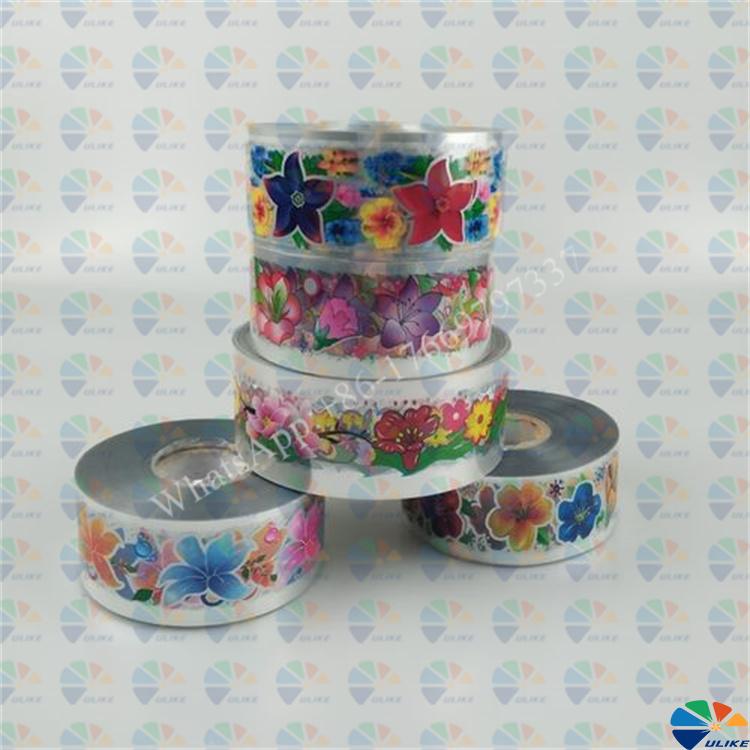Glass thermal transfer technology
Glass thermal transfer technology
1. Brief introduction of glass thermal transfer technology
Glass thermal transfer technology is a type of thermal transfer technology, which refers to a printing process that transfers thermal transfer patterns to glass products. This process is mainly divided into two processes:
①First, use a gravure printer to print the pattern image on the
heat-resistant base film;
②Then use thermal transfer equipment to transfer the image and text on the thermal transfer film to the glass product by heating and pressurizing.
2. Printing process of glass thermal transfer technology
The process of printing the pattern image on the heat-resistant base film using a gravure printer can be divided into the following 6 processes:
1. Release agent coating process; 2. Printing process; 3. Glue coating process; 4. Re-inspection process; 5. Striping process; 6. Hot packaging process of the stripped products.
In this process, attention should be paid to the design of the artwork. Due to the transparent nature of glass, when designing the transfer artwork of glass, attention should be paid to the pattern of light-colored dots or color blocks. A white background should be designed to prevent the pattern from being transparent, and the artwork design should be mainly based on the dot design to avoid affecting the adhesion of the pattern due to the thick printing ink layer.
3. Transfer process of glass thermal transfer technology
Application effect diagram of glass thermal transfer technology
The process of transferring the image and text on the thermal transfer film to the glass product through the thermal transfer machine is as follows:
1) After installing and debugging the fixed mold for thermal transfer of glass products, start to debug the parallelism and verticality of the thermal transfer machine. After the temperature of the thermal transfer machine rises to the set temperature, the thermal transfer operation of the glass product can be carried out.
2) When using glass thermal transfer film for transfer process, you should pay attention to whether the circumference of the rubber wheel on the hot stamping machine is longer than the length of the hot stamping pattern, because the thermal conductivity of glass is very good, which will absorb a lot of heat from the hot stamping rubber wheel. When the circumference of the hot stamping rubber wheel is smaller than the length of the hot stamping area, the hot stamping effect will be affected due to uneven heating of the rubber wheel.
IV. Key to glass thermal transfer technology
The above two processes are the main components of glass thermal transfer technology. Among these links involving the entire glass thermal transfer technology, the glass back glue (glue) is the decisive link of the whole process, because the adhesion is almost the only standard and the most difficult technical problem to solve in measuring the quality of glass thermal transfer technology. Glass back glue has become a stepping stone for this technology.
At present, the glass thermal transfer technology in the thermal transfer industry is uneven. Most manufacturers use imported glue from abroad, but the quality of glass thermal transfer printed films is also unstable. However, some manufacturers with technical research and development capabilities have developed their own glass backing glue, which has excellent adhesion and stable quality, and the quality of glass thermal transfer films is better guaranteed.

![af]() Afrikaans
Afrikaans![sq]() Albanian
Albanian![am]() Amharic
Amharic![ar]() Arabic
Arabic![fr]() French
French![es]() Spanish
Spanish![ru]() Russian
Russian![de]() German
German![hy]() Armenian
Armenian![it]() Italian
Italian![ja]() Japanese
Japanese![ko]() Korean
Korean![pt]() Portuguese
Portuguese![hi]() Hindi
Hindi![az]() Azerbaijani
Azerbaijani![ro]() Romanian
Romanian![pl]() Polish
Polish![th]() Thai
Thai![el]() Greek
Greek![eu]() Basque
Basque![en]() English
English![zh-CN]() Chinese (Simplified)
Chinese (Simplified)![zh-TW]() Chinese (Traditional)
Chinese (Traditional)![be]() Belarusian
Belarusian![bn]() Bengali
Bengali![bs]() Bosnian
Bosnian![bg]() Bulgarian
Bulgarian![ca]() Catalan
Catalan![ceb]() Cebuano
Cebuano![ny]() Chichewa
Chichewa![co]() Corsican
Corsican![hr]() Croatian
Croatian![cs]() Czech
Czech![da]() Danish
Danish![nl]() Dutch
Dutch![eo]() Esperanto
Esperanto![et]() Estonian
Estonian![tl]() Filipino
Filipino![fi]() Finnish
Finnish![fy]() Frisian
Frisian![gl]() Galician
Galician![ka]() Georgian
Georgian![gu]() Gujarati
Gujarati![ht]() Haitian Creole
Haitian Creole![ha]() Hausa
Hausa![haw]() Hawaiian
Hawaiian![iw]() Hebrew
Hebrew![hmn]() Hmong
Hmong![hu]() Hungarian
Hungarian![is]() Icelandic
Icelandic![ig]() Igbo
Igbo![id]() Indonesian
Indonesian![ga]() Irish
Irish![jw]() Javanese
Javanese![kn]() Kannada
Kannada![kk]() Kazakh
Kazakh![km]() Khmer
Khmer![ku]() Kurdish (Kurmanji)
Kurdish (Kurmanji)![ky]() Kyrgyz
Kyrgyz![lo]() Lao
Lao![la]() Latin
Latin![lv]() Latvian
Latvian![lt]() Lithuanian
Lithuanian![lb]() Luxembourgish
Luxembourgish![mk]() Macedonian
Macedonian![mg]() Malagasy
Malagasy![ms]() Malay
Malay![ml]() Malayalam
Malayalam![mt]() Maltese
Maltese![mi]() Maori
Maori![mr]() Marathi
Marathi![mn]() Mongolian
Mongolian![my]() Myanmar (Burmese)
Myanmar (Burmese)![ne]() Nepali
Nepali![no]() Norwegian
Norwegian![ps]() Pashto
Pashto![fa]() Persian
Persian![pa]() Punjabi
Punjabi![sm]() Samoan
Samoan![gd]() Scottish Gaelic
Scottish Gaelic![sr]() Serbian
Serbian![st]() Sesotho
Sesotho![sn]() Shona
Shona![sd]() Sindhi
Sindhi![si]() Sinhala
Sinhala![sk]() Slovak
Slovak![sl]() Slovenian
Slovenian![so]() Somali
Somali![su]() Sudanese
Sudanese![sw]() Swahili
Swahili![sv]() Swedish
Swedish![tg]() Tajik
Tajik![ta]() Tamil
Tamil![te]() Telugu
Telugu![tr]() Turkish
Turkish![uk]() Ukrainian
Ukrainian![ur]() Urdu
Urdu![uz]() Uzbek
Uzbek![vi]() Vietnamese
Vietnamese![cy]() Welsh
Welsh![xh]() Xhosa
Xhosa![yi]() Yiddish
Yiddish![yo]() Yoruba
Yoruba![zu]() Zulu
Zulu


